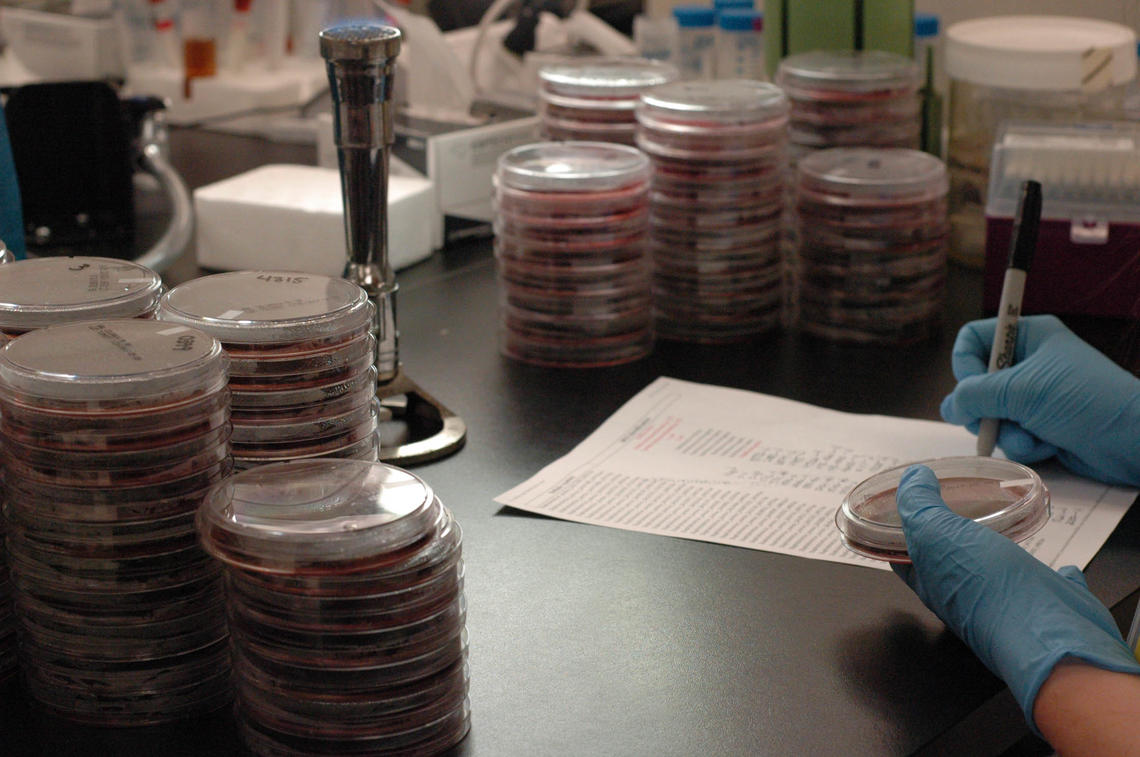June 7, 2019
New bacteria discovered at UCalgary named in honour of postdoc's supervisor

Nothing says "thank you" quite like naming a newly discovered bacterial species after your mentor.
So, that’s what Dr. Sohail Naushad, PhD, did when he realized he had identified a new species of staphylococcus, a group of bacteria first discovered in 1880 by a Scottish surgeon. Dr. Naushad, pictured above, made his discovery in a sample of cow’s milk while researching bovine mastitis with his supervisor, Dr. Jeroen De Buck, PhD, professor of bacteriology in the Faculty of Veterinary Medicine (UCVM).
“It all started when we were sequencing the genome of pathogens from milk samples. One day, I was analyzing a sequence that was supposed to be Staph aureus (a common and virulent strain of staphylococcus), and it didn’t seem to be Staph aureus. I thought it was potentially a new species,” says Naushad.
“When I was convinced it was a new species, I got the idea it should be named after a person who has been putting a lot of effort into combating bovine bacterial diseases. So, I named it Staphylococcus debuckii after my exceptional supervisor and mentor.”

Jeroen De Buck has a new bacterial species, Staphylococcus debuckii, named in his honour.
Riley Brandt, University of Calgary
Like finding hay in a stack of needles
“It’s quite a moment for a bacteriologist,” says De Buck. “Staphylococci are very well known, so it was a surprise that we found a new one within this well-studied genus. And then in a milk sample, not in a far corner of our planet somewhere. That was a big surprise. Like finding hay in a stack of needles.”
The findings were just published in the International Journal of Systematic and Evolutionary Microbiology, in a study by Naushad and researchers at UCVM, the University of Montreal, the University of Prince Edward Island, and the Canadian Bovine Mastitis and Milk Quality Research Network.
The discovery comes as part of a collaboration at UCVM between De Buck and Dr. Herman Barkema, professor of epidemiology of infectious diseases, to better understand bovine mastitis — a complex disease that’s endemic in the dairy industry and has major financial and cattle welfare implications.
“This is a great way to recognize Dr. De Buck’s research on infectious diseases of cattle. It reflects his strong sense of curiosity and his joy in tackling pertinent problems in the dairy industry with a fresh perspective and state-of-the-art technologies,” says Barkema. “While it is not clear yet how this discovery will benefit the dairy industry, it wouldn’t be the first time that new knowledge led to unexpected impacts down the road.”
“We don't even know if this organism we've found is a pathogen necessarily. It could actually be the opposite, and somehow protects against other mastitis pathogens,” says De Buck. “That's research we will be doing in the future.”

Finding a new species of a bacterial genus required a combination of scale and advanced tools.
Jeroen De Buck
Scale, techniques and cutting-edge tools
So, why were UCVM researchers able to make this discovery and not someone else? And why has Staphylococcus debuckii been hiding so long?
“Sohail did the work very comprehensively and at a large scale,” says De Buck. “We started analyzing a collection of 5,000 isolates, and so it's the scale, but also the advanced techniques and tools used that made us able to discover this. To discover another member of this well-known genus required that same combination of scale and tools.”
Naushad, an Eyes High and NSERC CREATE Postdoc Fellowship recipient who studied with De Buck for three years, is now a research scientist at the Canadian Food Inspection Agency.
“I'll keep doing science, I'll keep doing more exciting work, but finding a new pathogen and naming it for an exceptional supervisor, that’s something that will stay with me for life,” Naushad says.
“We had to take Jeroen’s name out as a PI on the paper, because there’s a rule that if you're naming the bacteria after someone he can’t be on the authorship,” he explains. “But in reality, the work and the guidance all came from him. I learned enormously from him, not only the science, but also how to be a good leader, how to be a good PI, how to be a good mentor and trainer. I would not be the person as I am today if I did not spend three years working with him.”
